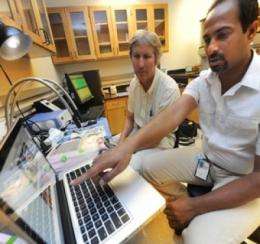Leg compressions may enhance stroke recovery

Successive, vigorous bouts of leg compressions following a stroke appear to trigger natural protective mechanisms that reduce damage, researchers report.
Compressing then releasing the leg for several five-minute intervals used in conjunction with the clot-buster tPA, essentially doubles efficacy, said Dr. David Hess, a stroke specialist who chairs the Medical College of Georgia Department of Neurology at Georgia Health Sciences University.
"This is potentially a very cheap, usable and safe – other than the temporary discomfort – therapy for stroke," said Hess, an author of the study in the journal Stroke. The compressions can be administered with a blood pressure cuff in the emergency room during preparation for tPA, or tissue plasminogen activator, currently the only Food and Drug Administration-approved stroke therapy.
"Much like preparation to run a marathon, you are getting yourself ready, you are conditioning your body to survive a stroke," Hess said of a technique that could also be used in an ambulance or at a small, rural hospital.
For the studies Dr. Nasrul Hoda, an MCG research scientist and the study's corresponding author, developed an animal model with a clot in the internal carotid artery, the most common cause of stroke.
The compression technique called remote ischemic perconditioning – "per" meaning "during" –reduced stroke size in the animals by 25.7 percent, slightly better than tPA's results. Together, the therapies reduced stroke size by 50 percent and expanded the treatment window during which tPA is safe and effective.
Next steps include looking for biomarkers that will enable researchers to easily measure effectiveness in humans, Hess said. One marker may be increased blood flow to the brain, which occurred in the treated animals. The first clinical trial likely will include putting a blood pressure cuff on the legs of a small number of stroke patients to see if the finding holds. The researchers also have plans to analyze the blood of healthy individuals, before and after compression, seeking mediators that stand out as clear markers of change. They also want to go back to the animal model to see if applying the technique after giving tPA works even better.
Clinical evidence already suggests that remote ischemic perconditioning can aid heart attack recovery, including a 2010 study in the journal Lancet in which the technique, used in conjunction with angioplasty to intervene in a heart attack, reduced heart damage.
Nature seems to support it as well since people who experience short periods of inadequate blood flow – angina in the case of heart disease and transient ischemic attacks in the brain – before having a major event tend to recover better than patients who have a full-blown stroke or heart attack out of the blue.
"Small episodes of ischemia seem to protect our organs – not just our brains – from major ischemia," said Hess, although the researchers are just starting to learn why. Theories include that leg muscles, in response to the temporary loss of blood and oxygen, somehow stimulate nerves to protect the brain and/or that the muscles themselves release the protection. They also suspect the vagus nerve, which delivers information to the brain about how other organs are doing and helps regulate inflammation, is a player.















